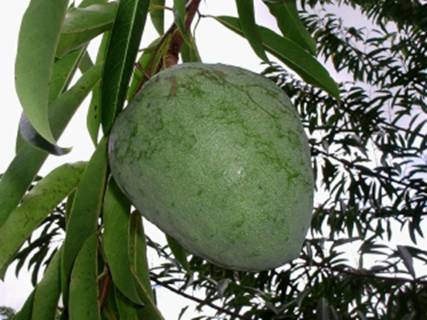ANNONA CACANS
POPULAR NAME: ARITICUM CAGÃO OR CORTIÇÃO.
ANNONACEAE

INDIGENOUS NAME: Araticum-pacarí, comes from the Tupi and means "fruit of soft mass" and Pacarí refers to "food of Paca".
Origin: semideciduous forest (which lose their leaves in a time of year) of Atlantic Forest from Minas Gerais to Rio Grande do Sul, Brazil
Characteristics: Tree of straight trunk, and the grey corky bark is peeling in long and narrow plates at the end of summer. Grows 5 to 15 m (17 to 50 feet) in height. The leaves are simple with elongated creamy yellow colored ribs.
Planted in the site of Frutas Raras: October 2003, flowered in 2006, bear fruit in 2007.
Tips for cultivation: Subtropical plant, resistant to frosts to - 3°C (27°F), can be grown throughout the country, at any altitude; adapts to any type of soil, which drain the rain water or even clay soils, subject the brink of flooding in rivers.
Propagation: Seeds are dormant when dry, when once planted, will germinate in 40 to 75 days. The seedlings grow faster, enjoy shaded environment for forming. The fruit begins in the age of 3 to 5 years depending on soil and cultural treatments.
Planting: Can be planted in full sun or mixed reforestation use for the wood, so you should plant a row of eucalyptus and pine and a line of Annona cavans one year after the planting of the first that will cause the plant grows upright, avoiding the dense branching when the plant is grown in full sun. Plant in the orchard in a space of 6 x 6 m (20 x 20 feet), water with 10 liters of water per week during the first 2 months.
Cultivating: Make only form pruning of the crown and remove branches that were grown from the base of the trunk, if you want to grow the tree. Or if you do prefer to produce a rounded crown, can remove the terminal bud and make modeling pruning every 2 months. Fertilize with organic compost, can be (8 liters) of chicken litter + 50 g of NPK 10-10-10 to double the amount every year until the 4th year.
Uses: Consume small amounts of fruit, because they are laxative, are also used to make juices and sweets. The wood is of excellent quality.
Flowering in the site of Frutas Raras: October and November.
Fruiting in the site of Frutas Raras: February to April.
Back to the seedlist (English) or back to Annonaceae (Portuguese)